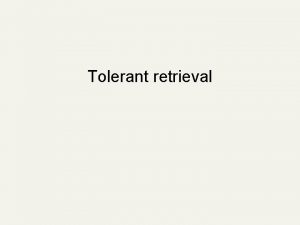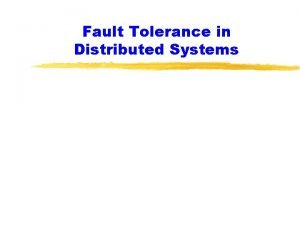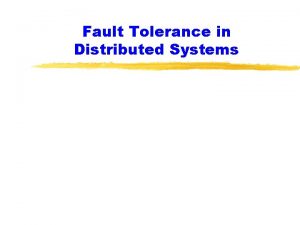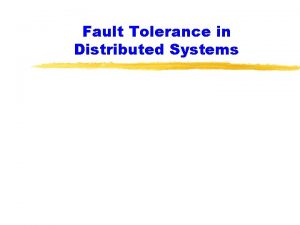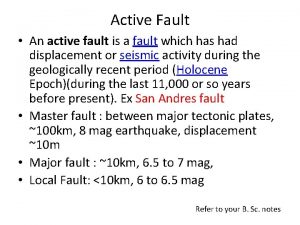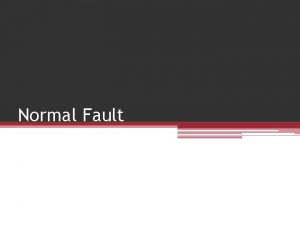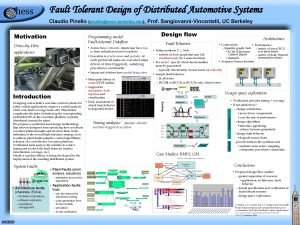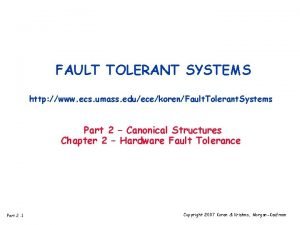FAULT TOLERANT SYSTEMS Fault tolerant Measures Part 1










- Slides: 10

FAULT TOLERANT SYSTEMS Fault tolerant Measures Part. 1. 1 Copyright 2007 Koren & Krishna, Morgan-Kaufman

Fault Tolerance Measures ¨It is important to have proper yardsticks - measures - by which to measure the effect of fault tolerance ¨A measure is a mathematical abstraction, which expresses only some subset of the object's nature ¨Measures? * * * Part. 1. 2 Copyright 2007 Koren & Krishna, Morgan-Kaufman

Traditional Measures - Reliability ¨Assumption: The system can be in one of two states: ‘’up” or ‘’down” ¨Examples: * Lightbulb - good or burned out * Wire - connected or broken ¨Reliability, R(t): Probability that the system is up during the whole interval [0, t], given it was up at time 0 ¨Related measure - Mean Time To Failure, MTTF : Average time the system remains up before it goes down and has to be repaired or replaced Part. 1. 3 Copyright 2007 Koren & Krishna, Morgan-Kaufman

Traditional Measures - Availability ¨Availability, A(t) : Fraction of time system is up during the interval [0, t] ¨Point Availability, Ap(t) : Probability that the system is up at time t ¨Long-Term Availability, A: ¨Availability is used in systems with recovery/repair ¨Related measures: * Mean Time To Repair, MTTR * Mean Time Between Failures, MTBF = MTTF + MTTR Part. 1. 4 Copyright 2007 Koren & Krishna, Morgan-Kaufman

Need For More Measures ¨The assumption of the system being in state ‘’up” or ‘’down” is very limiting ¨Example: A processor with one of its several hundreds of millions of gates stuck at logic value 0 and the rest is functional - may affect the output of the processor once in every 25, 000 hours of use ¨The processor is not fault-free, but cannot be defined as being ‘’down” ¨More detailed measures than the general reliability and availability are needed Part. 1. 5 Copyright 2007 Koren & Krishna, Morgan-Kaufman

Computational Capacity Measures Example: N processors in a gracefully degrading system ¨System is useful as long as at least one processor remains operational ¨Let Pi = Prob {i processors are operational} ¨Let c = computational capacity of a processor (e. g. , number of fixed-size tasks it can execute) ¨Computational capacity of i processors: Ci = i c ¨Average computational capacity of system: Part. 1. 6 Copyright 2007 Koren & Krishna, Morgan-Kaufman

Another Measure - Performability ¨Another approach - consider everything from the perspective of the application ¨Application is used to define ‘’accomplishment levels” L 1, L 2, . . . , Ln ¨Each represents a level of quality of service delivered by the application ¨Example: Li indicates i system crashes during the mission time period T ¨Performability is a vector (P(L 1), P(L 2), . . . , P(Ln)) where P(Li) is the probability that the computer functions well enough to permit the application to reach up to accomplishment level Li Part. 1. 7 Copyright 2007 Koren & Krishna, Morgan-Kaufman

Network Connectivity Measures ¨Focus on the network that connects the processors ¨Classical Node and Line Connectivity - the minimum number of nodes and lines, respectively, that have to fail before the network becomes disconnected ¨Measure indicates how vulnerable the network is to disconnection ¨A network disconnected by the failure of just one (critically-positioned) node is potentially more vulnerable than another which requires several nodes to fail before it becomes disconnected Part. 1. 8 Copyright 2007 Koren & Krishna, Morgan-Kaufman

Connectivity - Examples Part. 1. 9 Copyright 2007 Koren & Krishna, Morgan-Kaufman

Network Resilience Measures ¨Classical connectivity distinguishes between only two network states: connected and disconnected ¨It says nothing about how the network degrades as nodes fail before becoming disconnected ¨Two possible resilience measures: * Average node-pair distance * Network diameter - maximum node-pair distance ¨Both calculated given probability of node and/or link failure Part. 1. 10 Copyright 2007 Koren & Krishna, Morgan-Kaufman
 State machine replication blockchain
State machine replication blockchain Repeated measures design
Repeated measures design Was the ottoman empire tolerant of other religions
Was the ottoman empire tolerant of other religions Pressure tolerant vs pressure sensitive
Pressure tolerant vs pressure sensitive Heck tate is wise and tolerant
Heck tate is wise and tolerant Tolerant
Tolerant Tolerant retrieval
Tolerant retrieval Alt comparative superlative
Alt comparative superlative Recovery blocks software fault tolerance
Recovery blocks software fault tolerance Tpm technical performance measure
Tpm technical performance measure Addition symbol
Addition symbol






